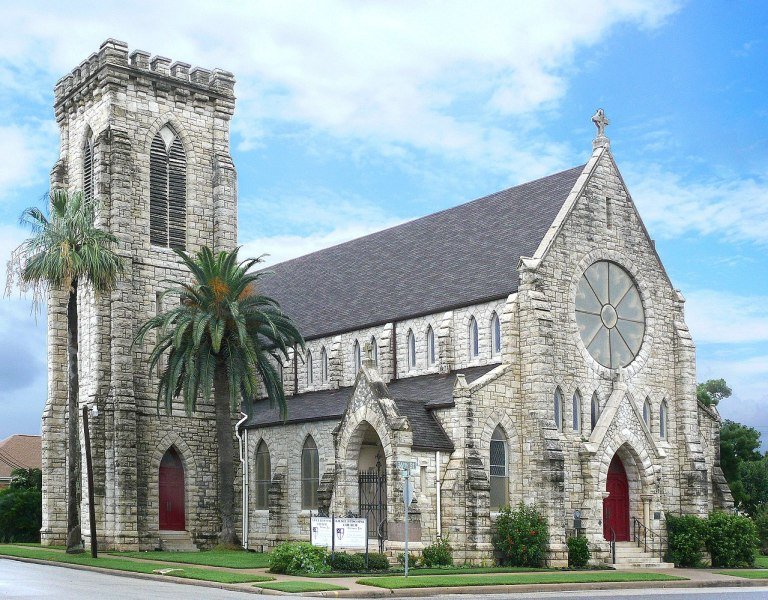Grace Episcopal Church
Recently, I attended the annual meeting of the Williams-Borden Neighborhood Association. It was held in the Parish Hall of the historic Grace Episcopal Church, located at 1115 36th Street.
The WBNA meeting gave me the perfect opportunity to visit the church for the first time.
Admittedly, the Parish Hall was a surprise. The building is impressive, not at all what I expected. The space inside is large and lovely. It features high, vaulted ceilings with exposed wood rafters. There are stained-glass windows all around. Immediately, I understood why the Parish Hall is a popular meeting place for our group.
Spending time in The Parish Hall made me want to take a peek inside the sanctuary of Grace, as well. I had heard often about its beauty, and I knew a bit about its history, including that it was dedicated as a National Landmark in 1975. Visiting this beautiful sacred place would be a memorable experience.
In 1884, wealthy Galveston businessman and philanthropist Henry Rosenberg and his wife, Leticia, moved their church membership to Grace Episcopal Church (due to a major disagreement). After Leticia’s death, Rosenberg married Mollie Macgill. Two years later, Rosenberg left a bequest of $30,000 to replace the Grace’s small frame church with the beautiful neo-Gothic building that stands today. Consecrated in 1895, the Leon limestone building was designed by noted architect Nicholas Clayton.
Mollie Rosenberg donated $10,000 of her own money for the church’s interior furnishings and many of its incredible stained-glassed windows. The magnificent hand-carved reredos and altar have been called “the richest ever been put in any church in the south.” Other gifts of “Aunt Mollie,” as she is still affectionately known, include the bronze statue of Gabriel, the brass pulpit, the bishop’s chair, credence table, chancel railings, clergy stalls and all the oak pews. Succeeding generations of Grace Episcopal Church members have added memorials, including bronze tablets, candelabra, hand-stitched linens and the Christos Rex in the chapel.
A survivor of the Great Storm of 1900 and Hurricane Ike in 2008, Today, it continues to stand strong in the Galveston community. It serves as a spiritual home for a large and diverse congregation.
-
2022
- Mar 17, 2022 Ivy Dishes
- Jan 29, 2022 Grace Episcopal Church
- Jan 1, 2022 100 Years
-
2021
- Aug 25, 2021 My Fig Tree
- Apr 28, 2021 Darlene's Shrimp
- Apr 24, 2021 Oleander Festival
- Feb 27, 2021 Great Winter Storm
- Feb 10, 2021 The Mourning Wave
-
2020
- Oct 26, 2020 Crepe Myrtles
- Sep 18, 2020 Trimming the Palms
- Jul 19, 2020 The Dancers
- Jul 11, 2020 Postcards
- Jun 20, 2020 Resilience Flag
- Jun 19, 2020 Juneteenth
- Jun 10, 2020 Silk Stocking
- May 27, 2020 Tree Sculptures
- May 6, 2020 Babe's Beach
- Apr 22, 2020 Opera House
- Mar 2, 2020 Texas Heroes Monument
- Feb 15, 2020 Mardi Gras Parade
- Jan 19, 2020 St. Joseph's Church
-
2019
- Dec 15, 2019 Celebrations
- Nov 6, 2019 Fresh Paint
- Oct 21, 2019 Jazz Age Series
- Oct 20, 2019 ARToberFEST
- Oct 6, 2019 Stingeree
- Oct 5, 2019 Pumpkin Time
- Oct 2, 2019 Sea Turtles
- Sep 29, 2019 Powhatan House
- Sep 24, 2019 The Dolphins
- Sep 5, 2019 Lucas Apartments
- Aug 24, 2019 Sandcastles
- Aug 9, 2019 The Daily News
- Jul 18, 2019 Beach Walk
- Jul 10, 2019 La King's
- May 25, 2019 Pleasure Pier
- May 1, 2019 Bolivar Ferry
- Mar 15, 2019 Saengerfest Park
- Jan 19, 2019 Moody Mansion
-
2018
- Dec 18, 2018 The Vintage Suitcase
- Dec 17, 2018 Festival of Lights
- Dec 2, 2018 Sunday Brunch
- Nov 21, 2018 Hendley Row
- Oct 27, 2018 Island Oktoberfest
- Sep 20, 2018 The Strand Clock
- Sep 16, 2018 St. Mary Cathedral
- Aug 11, 2018 No More Shed
- Jun 10, 2018 Rosenberg Library
- May 7, 2018 Stepping It Up
- May 3, 2018 A Happy Hour
- May 1, 2018 Ashton Villa
- Apr 21, 2018 96th Birthday
- Apr 1, 2018 Seawolf Park
- Mar 27, 2018 Ball High School
- Mar 15, 2018 East End
- Feb 1, 2018 Tremont House
- Jan 26, 2018 Menardi Gras
- Jan 24, 2018 Mardi Gras Decor
-
2017
- Dec 1, 2017 Miss Ruby
- Oct 8, 2017 Railroad Museum
- Oct 7, 2017 Tall Ship Elissa
- Sep 9, 2017 Star Drug Store
- Sep 8, 2017 1900 Storm Statue
- Aug 6, 2017 The Turquoise Table
- Aug 1, 2017 Bishop's Palace
- Jul 23, 2017 Garten-Verein
- Jul 21, 2017 Yard Work
- Jul 16, 2017 The Strand
- Jun 17, 2017 Stewart Beach
- Jun 7, 2017 The Original
- Jun 3, 2017 Murdochs
- May 27, 2017 Bryan Museum
- May 19, 2017 Firemen on Call
- May 13, 2017 Williams-Borden Neighborhood
- May 1, 2017 Oleander City
- Apr 28, 2017 God Winks


